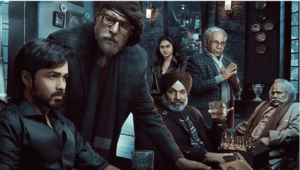The Allahabad High Court’s recent decision in Uday Prakash v. Anand Pandit and Anr. [FAO (D) 432/2021; Order dated 27th August 2021] was particularly illuminative with respect to certain established principles under Indian copyright law, while also shedding light on the procedural requirements in a quia timet action and applications for temporary injunctions. The Court herein was hearing an appeal from an Order of the Ld. District Judge, Ghaziabad, wherein the Plaintiff-Applicant’s application for temporary injunction on account of infringement of copyright was rejected. A summary of the brief facts followed by the Court’s findings and a brief reflection / analysis of the same is provided below:
BRIEF FACTS
The Plaintiff had instituted a suit before the District Judge, Ghaziabad, for infringement of copyright owned by the Plaintiff relating to a literary work titled ‘Highway-39’ (“Plaintiff’s Work”), which he had also gotten registered on 16.07.2007 with the Copyright Office at New Delhi under Registration No. L-28822/2007. The Plaintiff claimed to have discussed the Plaintiff’s Work with a Mr. Mazhar Karman, as he had assured the Plaintiff that he will show the Plaintiff’s Work to a few prominent producers in the film industry, which included Defendant No. 1.
The Plaintiff further claimed that, in June 2019, he came to know from ‘reliable sources in the film industry’ that Defendant No. 1 was producing a movie titled ‘Chehre’ (“Impugned Work”) which is very similar to the Plaintiff’s Work. Defendant No. 2 is the director of said movie, and was accordingly impleaded in this suit as well. The Plaintiff sent a cease-and-desist legal notice to the Defendants on 14.06.2019, asserting that the Impugned Work infringes copyright in the Plaintiff’s Work and accordingly seeking stoppage of production of the Impugned Work. However, the Defendants replied to said notice on 29.06.2019, wherein it wholly denied any copyright infringement by the Impugned Work.
It is also notable that in the Written Statement filed by the Defendants, a similar stance was adopted and it was asserted that the Plaintiff’s Work was devoid of ingenuity / originality and was merely an adaptation of the novel, ‘A Dangerous Game’, by Friedrich Durrenmatt. It was further contended that the Plaintiff’s suit was merely a quia timet action (as the Impugned Work was not to be released in February 2020, as was alleged by the Plaintiff), which was founded on unreliable sources and erroneous apprehensions.
Asides from the overarching issue of infringement of copyright in the Plaintiff’s Work, the Court in this appeal was also dealing with / revisiting the following pertinent legal issues:
- Is the Defendant obligated to provide access to the allegedly infringing work (herein, the script of the Impugned Work) to the Plaintiff, in order to allow the latter to substantiate its claims of infringement of copyright?
- What are the appropriate legal principles to be applied while dealing with a quia timet action, specifically when such action is purportedly instituted on the basis of tenuous apprehensions?
- Can the Defendant be deemed to have ‘access’ to the original work on the basis of merely vague assertions to that effect?
FINDINGS OF THE COURT
At the outset, the Court reiterated the settled legal principles to ascertain whether a prima facie case for infringement of copyright, in an application for temporary injunction, is made out. Namely, the Plaintiff’s Work must be shown to be an original work, the Defendant should have had access to the same and the Impugned Work must be shown to be substantially similar to the Plaintiff’s Work. The Court then proceeded to apply this criteria to the instant factual matrix, and observed as follows:
“28. Now, the question whether a prima facie case is made out, is intrinsically connected to the cause of action regarding infringement of the copyright alleged. It is true that in order to establish a prima facie case, in an action for infringement of copyright, there have to be pleadings to establish that the literary work, of which the plaintiff claims infringement by the defendants should be shown to be the plaintiff’s original literary work, in the sense that the work is at least original rendition of a known theme with the plaintiff producing it, employing his knowledge, labour and skill. In addition, it has also to be established that the defendant had access to the plaintiff’s work, and that the offending script is substantially similar to the plaintiff’s script. Here, there is no doubt about one fact that the plaintiff holds a copyrighted work. But beyond that, the pleadings are utterly vague. There is an assertion to the effect that the plaintiff discussed the copyrighted work with Mazhar Kamran, but it does not say that he showed the copyrighted work to Kamran or handed it over to him. Therefore, there is a very vague case pleaded about the intermediary who could have possibly palmed off the copyrighted work to the defendants, on coming to know of its contents. A mere discussion of a work involving intellectual intricacies with another is not a case enough to impute that other with knowledge of its contents; and knowledge good enough to share it with a third party. The pleadings, therefore, are woefully vague about the access of the defendants to the copyrighted work.
29. The next assertion in the plaint that the plaintiff was given information about defendant no. 1 producing the feature film, that is essentially similar to the copyrighted work, is also utterly vague. It is set out in Paragraph no.5 of the plaint. The plaintiff does not name the source through which he came to know that the feature film is based on a script that is a plagiarized version of the copyrighted work. The terms employed in the relevant pleadings are “reliable source/sources from the film industry” which can hardly go to make for a prima facie case or a triable case for the grant of a temporary injunction in an action for infringement of copyright.
30. There is another issue which is required to be addressed. It is connected to the fundamental issue about whether the plaintiff at all had a cause of action to proceed for infringement with the kind of allegations that find place in the plaint. Prima facie, the plaintiff never had occasion to see what the contents of the script leading to the feature film were, the movie having not been released as yet and certainly not until time the suit was filed. The plaintiff has inferred that it is a copy of his work on the basis of some hearsay, that he has expressed through vague allegations in the plaint, describing them as reliable sources from the film industry. The entire action is, therefore, based on the plaintiff’s conjecture. This cannot be the basis of an action for infringement of copyright.”
In conjunction with the aforementioned observations, the Court also stated that in a quia timet action, the evidence about threat of injury should be tangible and concrete and cannot be based off bald assertions and hypothetical facts. That is to say, the burden of proof in a quia timet action is much heavier than in a case where an actual injury has already occurred. Although the Plaintiff tried to rebut the Court’s findings in this regard by asserting that the potential threat of injury has become increasingly potent in light of the impending release of the Impugned Work, the Court rebuffed this contention as the Plaintiff had still failed to make out a prima facie case on the similarity between the two works. It was reiterated herein by the Court that the Plaintiff’s case was built on mere hearsay and conjecture, and such vague pleadings do not meet the requisite threshold to make out a prima facie case of infringement of copyright.
At this juncture, the Court also dealt with the Plaintiff’s contention that its failure to further substantiate its pleadings must be attributed to the Defendant’s refusal to provide access to the script of the Impugned Work, as in the absence of proper access to said script the Plaintiff could not provide an in-depth comparison of the alleged similarities between the two works. The Court opined that such refusal on the part of the Defendant was an ancillary issue, with the suit more likely to fail or succeed on the questions of whether the Defendant had access to the Plaintiff’s Work in the first place and whether an ordinary person upon comparing the two works would conclude that the latter work is a copy of the former. Relevant observations in this regard are reproduced below:
“39. Therefore, the question that is required to be addressed is not about the burden of proof, or so to speak, the defendants’ burden as the plaintiff claims, once they (the defendants) opposed the application for discovery to disclose the contents of the script that is the basis of the feature film, but whether the plaintiff has a triable case pleaded on the parameters of an action for infringement. It has already been held that there is absolutely vague pleading to show that the defendant could have had access to the copyrighted work. The Court in Mansoob Haider no doubt, has said that failing on the point of access, the plaintiff can still succeed, upon showing that on a comparison of the two works, an ordinary person would inevitably conclude that defendants had copied the plaintiff’s work. There is some doubt whether access has to be necessarily proved, but assuming that it is required to be proved, it would still be necessary for the plaintiff to plead and show that an ordinary person, in comparing the copyrighted work and the feature film, would inevitably come to the conclusion that the latter is a copy of the former.”
Pertinently, the Defendant had agreed to place upon the copy of its script before the Court (although the Plaintiff was still denied access to the same). Therefore, the Court was able to undertake a comprehensive assessment of the two works and to compare similarities (if any) between these works. Upon doing so, the Court agreed with the Defendant’s contention that the works are inspired by the novel, ‘A Dangerous Game’, which thus constituted the underlying idea behind both works. However, as per well-settled principles copyright law, what is material is the treatment / expression of this idea in the two works. Keeping this in mind, the Court finally found that the common theme / idea behind the two works has been expressed in a materially different and distinct manner, and thereby no case for copyright infringement can be made out at this interim stage. The Court did however expressly remark that its observations pertain to the temporary injunction alone, and a final expression on the similarities of the two works could only be delivered after trial has been conducted. The Court also briefly remarked on the potential remedies to be provided to the Plaintiff, in case he succeeds in trial, and also directed the lower court to expedite trial in the instant suit. The Court’s final observations are reproduced below:
“54. There is, thus, prima facie a materially different and distinctive development and treatment of the same theme in both the scripts. In the prima facie opinion of this Court, there is, apart from the fundamentals of the basic theme that appear to have come from a common source, no such distinctive feature in the copyrighted version that have been prima facie plagiarized. It must be remarked here that whatever comparison has been done, is not, in any manner, a final expression of opinion on merits about the distinctive similarities or the dissimilarities. That is something that has to await trial, where wholesome evidence would now be led. All the remarks here are limited to the decision of the temporary injunction matter and nothing more.
55. Now, a still further issue that is required to be examined is what would happen if at the hearing, the plaintiff were to ultimately succeed. Would damages alone be recompense enough? There is relief sought by way of a decree for rendition of accounts of the advance amount received by the defendants from the distribution companies, television channels, OTT platforms, television networks by selling distribution rights/ streaming rights of the feature film, infringing the plaintiff’s copyright. The said decree would entitle the plaintiff, if he succeeds, to proportionate proceeds on account, as may be determined that the film earns. But, apart from that, if the copyright is ultimately held to be infringed at the trial, monetary compensation may not be recompense enough. It is, therefore, to be ordered that if the plaintiff succeeds, all further displays of the feature film shall have to carry an acknowledgment, suitably to be displayed that the movie is based on the copyrighted work, which is the plaintiff’s authorship. Also, the trial of the suit is to be expedited. Since the learned District Judge is hearing the suit himself, he will proceed with the suit, fixing one date every week and endeavour to conclude the trial within four months.”
CONCLUDING REMARKS
The Allahabad High Court’s decision is certainly a well-reasoned and comprehensive one, which delves extensively into settled tenets of Indian copyright law and reinforces the same. The idea-expression dichotomy drawn out in the instant case is in line with the findings of the Supreme Court in its seminal judgment in R.G. Anand v. Delux Films and Ors. [(1978) 4 SCC 118], and the Court’s detailed breakdown of the similarities (or lack thereof) between the two works is premised upon this dichotomy as well, on the basis of which it ascertained that a prima facie case has not been made out by the Plaintiff.
Additionally, the Court’s decision to not draw an adverse inference against the Defendant’s refusal to produce its script for the Plaintiff’s perusal is also prudent in light of this particular factual matrix, as there was no cause of action made out in the Plaintiff’s vague pleadings which could have been relied upon to compel the Defendant to disclose the script of its Impugned Work (which would have certainly had adverse commercial implications for the Defendants, given the massive scale of the Impugned Work and the numerous stakeholders involved in the production and distribution of such feature films). This aspect of the decision was also intrinsically linked with the Plaintiff’s failure to prove that the Defendant had access to the Plaintiff’s Work, thereby underscoring the importance of proving ‘access’ to an original work in a suit for infringement of copyright.
All-in-all, this decision of the Allahabad High Court helps fortify settled tenets of Indian copyright law while also providing further clarity on the relevant factors to be accounted for by a court of law while dealing with alleged copyright infringement (at the interim stage) in a quia timet action.
Image source: here

















![Madras High Court decides on the dispute between Star India, Vijay TV against TRAI- dissenting judgement given by Chief Justice Indira Banerjee [READ JUDGEMENT]](https://iprmentlaw.com/wp-content/uploads/2018/03/mad-hc-100x70.jpeg)
![Breaking: Delhi High Court dismisses the 2006 suit filed by IPRS against Aditya Pandey and others, imposes costs of INR 2 Lacs [READ JUDGEMENT]](https://iprmentlaw.com/wp-content/uploads/2018/04/IPRS-100x70.png)